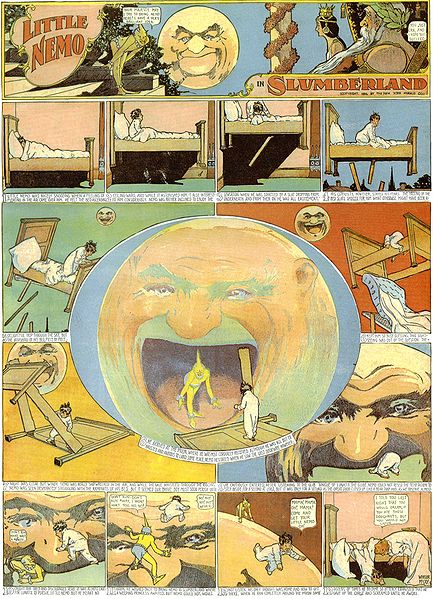This diminishing of things, as if
Sleep were a miniaturist working
In the darkness, to the dimensionsOf a mini-theatre echo-chamber
Through which stray air currents dragged their ghosts:
A point of light appearing in the dream,
A glimmer almost swallowed by the room's
Dark corners at first, grown in a little while
To the restless thought sleep's escaped again.
The thought cast its anxious reflex into
The dream, and I awakened then, castaway,
Drenched in the sunshaded stones of afternoon.

Little Nemo in Slumberland: Winsor McCay (1905-1914)


Incredible comics, the first 2 who are they from? is it the same guy that says at the bottom?
ReplyDeleteAnd I like the text with the idea of diminishing things while you dream,reminds me of alice a little bit.
Bye friend
ni parcs, ni lilacs--all irregular vegetation banished from this reductive dream?
ReplyDeletethese days I feel like the troupeau abruti I teach at a community college: trop pauvre acheter Obama's fireside chats.
Rode the acoustics and images from the first word to the last. Home run: "Drenched in the sunshaded stones of afternoon."
ReplyDeleteI'm with otto. The acoustics, esp. for me the d's and g's, hesitancy and something almost like stuttering or subvocalization in that. The alliteration strings together the fantastic series of lines, each of them a perfect statement of a new phase of somatic anxiety that becomes, in irresistible sequence, an argument about the real. The final line, a home run as otto says, is mysterious and brilliant, almost literally so, the feeling of a light too strong to endure, yet the stones are sunshaded, not out in the glare -- maybe a shade too strong to endure?
ReplyDeleteMariana,
ReplyDeleteThese images are all from Little Nemo in Slumberland by Winsor McCay, the poet of the early years of comic strips. He started the Nemo series with Hearst's New York American in 1905 and kept it going for many years. (And then in 1913 he created the first animated cartoon, Gertie the Dinosaur.) McCay was a genius in this field, the first comic strip artist to exploit color for purely aesthetic purposes, the first to seed his dialogue with polysyllabic words and adult ironies. McCay's only serious rivals in this area were George Herriman with his Krazy Kat (see the previous post) and Walt Kelly with his Pogo. Nemo is always a tousle-haired boy somewhere between six and eight years of age. His dream adventures and journeys are often dark and strange. Just when things get dicey, some unexpected event in the dream causes Nemo to awaken. He is the poetic descendant of the Nemo/Nobody figures of Germanic storytelling. McCay's work recalls that of Grimm and Andersen. Time and space are warped past recognition, fantasy reigns supreme. Byzantine backdrops, strange majestic animals, classical architecture, opulent color, and rococo landscaping remove the work from the realm of naturalism into an imaginal zone of dream and nightmare. Yet all this exotic stuff is supported by a lovely affectionate humor that always dispels the dangers just in time. There is nothing else quite like it.
David,
Métro, boulot, dodo, uh-oh !
(Moi aussi, mais sans boulot.)
No lilacs in the twilight zone park...
Otto, Alva,
Thanks for understanding how this one ticks. Why do the stones give off that blinding glare if they are drenched in shade, or is it the awakened dreamer who is drenched, sweating out his inability to sleep in the dream?
Yes they are, thank you. You know I never even knew what they were or what they looked like. Really! I do not lie. I just write what comes to me! Ha! See I told you I am a crazy English Woman!
ReplyDeleteSomeone once told me how important it is for a writer, to close with a line that sticks in the readers mind, long after they have read what's written.
'Drenched in the sunshaded stones of afternoon'
This will resonant within me for the remainder of the day and perhaps longer.
Tom, this is a lovely poem--and I like what Alva says about it (hi Alva!). I'll have to check out Little Nemo. Bedtime reading at Chez Smith-Nguyen lately has consisted of The Adventures of Tintin, the Beglian comic series from the thirties.
ReplyDeleteAh, we used to have a copy of Little Nemo (it's probably still at Ashley's house, down on Brighton, which I just made mention of in the comment I left after your lovely Jim Carroll piece from September, read just now), I too should check it out again (as Dale says here), have just now started reading Tintin to little Johnny (about to turn 5), who got a copy of The Castafiore Emerald for Christmas.
ReplyDelete